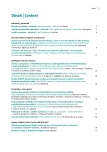A rare case of mobile atherosclerotic plaque with a high embolic potential in the femoral artery
Authors:
Daniel Rob 1; David Ručka 1; Miroslav Chochola 1; Debora Karetová 1; Jan Hrubý 2; Eliška Kusová 3; Jean Claude Lubanda 1
Authors‘ workplace:
II. interní klinika kardiologie a angiologie 1. LF UK a VFN Praha
1; II. chirurgická klinika kardiovaskulární chirurgie 1. LF UK a VFN Praha
2; Radiodiagnostická klinika 1. LF UK a VFN Praha
3
Published in:
Vnitř Lék 2016; 62(1): 52-56
Category:
Case Reports
Overview
Atherosclerosis is a diffuse disease which may lead to the development of unstable atherosclerotic plaque. Its rupture can result in acute ischemic event. The atherosclerotic plaques with a mobile component are typical presentations of such instability and patients with these plaques are at high risk of acute ischemic events. In the current literature, substantial data regarding the mobile atherosclerotic plaques in carotid arteries and thoracic aorta is published. However there are almost no data concerning the mobile plaques in the peripheral arteries of the lower limbs. We present a rare case of a patient with generalized atherosclerosis, in whom an asymptomatic mobile atherosclerotic plaque in the common femoral artery with a high embolic potential was diagnosed. This plaque was successfully removed by femoral endarterectomy. On the basis of this case, we review the possibilities and limitations of the current imaging methods in detection of mobile plaques in the peripheral arteries. Moreover optimal therapeutic approaches in such patients are discussed.
Key words:
acute limb ischemia – atherosclerosis – embolism – endarterectomy – mobile plaque – thrombosis – unstable plaque – vascular sonography
Sources
1. Naghavi M, Libby P, Falk E et al. From vulnerable plaque to vulnerable patient a call for new definitions and risk assessment strategies: Part I. Circulation 2003; 108(14): 1664–1672.
2. Norgren L, Hiatt WR, Dormandy J et al. Inter-society consensus for the management of peripheral arterial disease (TASC II). Eur J Vasc Endovasc Surg 2007; 33(Suppl 1): S1-S75.
3. Finn AV, Nakano M, Narula J et al. Concept of vulnerable/unstable plaque. Arterioscler Thromb Vasc Biol 2010; 30(7): 1282–1292.
4. Khurana D, Saini M, Laldinpuii J et al. Mobile plaque in the internal carotid artery: A case report and review. Ann Indian Acad Neurol 2009; 12(3): 185–187.
5. Irvine C, George S, Sheffield E et al. The association of platelet-derived growth factor receptor expression, plaque morphology and histological features with symptoms in carotid atherosclerosis. Cardiovasc Surg 2000; 8(2): 121–129.
6. Spagnoli LG, Mauriello A, Sangiorgi G et al. Extracranial thrombotically active carotid plaque as a risk factor for ischemic stroke. JAMA 2004; 292(15): 1845–1852.
7. Tunick P, Rosenzweig B, Katz E et al. High risk for vascular events in patients with protruding aortic atheromas: a prospective study. J Am Coll Cardiol 1994; 23(5): 1085–1090.
8. Khatibzadeh M, Mitusch R, Stierle U et al. Aortic atherosclerotic plaques as a source of systemic embolism. J Am Coll Cardiol 1996; 27(3): 664–669.
9. Dressler FA, Craig WR, Castello R et al. Mobile aortic atheroma and systemic emboli: efficacy of anticoagulation and influence of plaque morphology on recurrent stroke. J Am Coll Cardiol 1998; 31(1): 134–138.
10. Harloff A, Simon J, Brendecke S et al. Complex plaques in the proximal descending aorta an underestimated embolic source of stroke. Stroke 2010; 41(6): 1145–1150.
11. Dúbrava J, Garay R. Význam transezofageálnej echokardiografie v detekcii kardiogénnej a aortálnej embolizácie pri ložiskovej ischémii mozgu a tranzitórnych ischemických atakoch. Vnitř Lék 2006; 52(2): 144–151.
12. Fayad, ZA, Fuster V Clinical imaging of the high-risk or vulnerable atherosclerotic plaque. Circ Res 2001; 89(4): 305–316.
13. Herisson F, Heymann MF, Chétiveaux M et al. Carotid and femoral atherosclerotic plaques show different morphology. Atherosclerosis 2001; 216(2): 348–354.
14. Štěchovský C, Horváth M, Hájek P et al. Význam vulnerabilních aterosklerotických plátů a možnosti jejich detekce pomocí intravaskulární spektroskopie. Vnitř Lék 2014; 60(4): 375–379.
15. Moncayo KE, Vidal JJ, García R et al. Surgical management of a mobile floating carotid plaque. Interact Cardiovasc Thorac Surg 2015; 20(3): 443–444.
16. Combe J, Poinsard P, Besancenot J et al. Free-floating thrombus of the extracranial internal carotid artery. Ann Vasc Surg 1990; 4(6): 558–562.
17. Nishiga M, Izumi C, Matsutani H et al. Effects of Medical Treatment on the Prognosis and Risk of Embolic Events in Patients with Severe Aortic Plaque. J Atheroscler Thromb 2013; 20(11): 821–829.
18. Ballotta E, Gruppo M, Mazzalai F et al. Common femoral artery endarterectomy for occlusive disease: an 8-year single-center prospective study. Surgery 2010; 147(2): 268–274.
19. Kang JL, Patel VI, Conrad MF et al. Common femoral artery occlusive disease: contemporary results following surgical endarterectomy. J Vasc Surg 2008; 48(4): 872–877.
20. Tendera M, Aboyans V, Bartelink ML et al. ESC Guidelines on the diagnosis and treatment of peripheral artery diseases Document covering atherosclerotic disease of extracranial carotid and vertebral, mesenteric, renal, upper and lower extremity arteries. The Task Force on the Diagnosis and Treatment of Peripheral Artery Diseases of the European Society of Cardiology (ESC). Eur Heart J 2011; 32(22): 2851–2906.
21. Ness J, Aronow W. Prevalence of coexistence of coronary artery disease, ischemic stroke, and peripheral arterial disease in older persons, mean age 80 years, in an academic hospital-based geriatrics practice. J Am Geriatr Soc 1999; 47(10): 1255–1256.
Labels
Diabetology Endocrinology Internal medicineArticle was published in
Internal Medicine

2016 Issue 1
Most read in this issue
- Toxic epidermal necrolysis
- Changes in the prognosis and treatment of Waldenström macroglobulinemia. Literature overview and own experience
- Significance of alanine aminotransferase screening in blood donors for risk reduction of hepatitis B and C transmission by haemotherapy
- A rare case of mobile atherosclerotic plaque with a high embolic potential in the femoral artery
